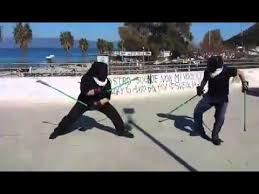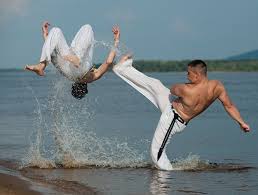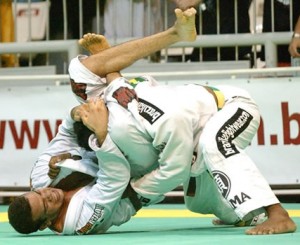Pankration
 Pankration is an ancient Olympic type of martial arts, revived in our time. Pankration entered the program of the ancient Olympic Games in 648 BC. The origin of this martial art is associated with the legends of the ancient Greek heroes of Theseus and Heracles. Theseus used a similar battle technique in the battle with the Minotaur, and Hercules used the pankration in the fight against the Nemean lion.
Pankration is an ancient Olympic type of martial arts, revived in our time. Pankration entered the program of the ancient Olympic Games in 648 BC. The origin of this martial art is associated with the legends of the ancient Greek heroes of Theseus and Heracles. Theseus used a similar battle technique in the battle with the Minotaur, and Hercules used the pankration in the fight against the Nemean lion.
Pankration began on the 4th day of the Olympic Games and consisted of a duel between two athletes. Competitions were held on a special platform, covered with a layer of sand. It was in pankration that one could determine the most powerful and courageous athletes. Pankration was the most difficult competition in ancient games and combined the techniques of fighting in the stance, stalls, sweeps, painful and suffocating techniques. It was possible to fight with the help of arms, legs and head. It was possible to beat the recumbent, but at the same time, the recumbent opponent could beat the opponent while lying. It was in this martial art that athletes first began to strike in a jump and combine strikes with grabs.
Pankration came from the Egyptian struggle, the Babylonian fist fight, Cretan boxing, the Greek fist fight. The reason for the occurrence of pankration was the constant violation by athletes of the rules in wrestling and fist fighting, which gave rise to martial arts without any rules and restrictions. In this martial art it was not allowed only to bite, scratch and beat in the eyes. There were no distinctions by weight categories, the time of the battle was not determined. The judge was present during the battle in order to prevent the death or serious injury of one of the fighters.
If the fighter surrendered, he raised his thumb or clapped on the body of the enemy. The judge had to stop the fight, but it was not always possible to do this on time.
In ancient Sparta, pankration existed in an even more cruel form, in addition, women participated in the battles.
The winners of such competitions were proclaimed heroes of Greece, their names were placed on special lists, their most beautiful girls were crowned with laurel wreaths. After the victory of the Romans over the Greeks, pankration was replaced by gladiatorial battles.
Nowadays, pankration has survived a rebirth, but the new version is much less dangerous than its predecessor. In battles, they introduced time limits, the use of protection that reduces the risk of injury. However, opponents are still allowed to apply almost any tricks from any position.
Martial arts revived in the 60s of the last century, American Jim Arvantis. He called his system modern Greek karate. It was pankration that was the basis of fights without rules.
In the USSR, in the late 70s and early 80s, Alexander Valdaytsev developed a project for holding pankration competitions, its rules, and the equipment of the participants. With the participation of Valdaitsev with like-minded people, the pankration spread throughout the republics of the USSR. In 1991, the first championship in this single combat was held in Russia, since then it has been held regularly.
Pankration competitions are now held in more than 120 different countries, united in three parent organizations located in Ireland, Russia and Greece.
In addition to the “Federation of Pankration of Russia”, this kind of full-contact sport is developed by the sports center “Pankration”. This center has been distributing pankration in the Russian Federation and abroad since 1991. The organizer of this association is Stepkin V.M. is a judge of the international category. Until this time, the organization held more than 50 competitions. Every year the center holds the “Cup of Russia” in professional pankration.
Amateur pankration is held in one round, lasting 3 minutes in children and 5 in adults. Protective equipment includes a helmet, gloves, a bandage. All techniques of athletes are evaluated with the help of points: each type of blow brings a certain amount to the fighter. It is forbidden to hit in the groin, on the knees, spine, back of the head, to poke in the eyes and throat, to hit the recumbent, to turn your back to the opponent during an attack, etc. First, a warning is issued for the first violation in the battle, and a warning except for the second 2 points are added to the opponent, after three warnings the athlete will be disqualified.
In professional pankration, the battle time is limited to two rounds of 5 minutes. If during this time one of the athletes did not win a clear victory, after the break they continue the fight for another 3 minutes. And if no one clearly wins in the additional time provided, the result is determined by a council of three people – the inspector, the chief judge and the referee.
During the competition, athletes can apply almost all the techniques of all known types of martial arts – freestyle wrestling, Greco-Roman wrestling, sambo, karate, boxing, etc. It is forbidden to strike in the eyes, throat, groin, on the spine, back of the head, grabbing the opponent by the hair, insult him, beat the recumbent, conduct a passive battle. At the first violation, the fighter is warned, and in case of repeated violation, he will be disqualified.




